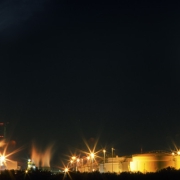LNG – The nature of the beast
/0 Comments/in Long Articles/by Rudolf HuberThe greatest enemy that any human ever faces lies within oneself. It seems to be the most fundamental of all human natures. Our shallowness. Our love for the simplified.
Our fear of our true selves.
Few persons ever face their inner demons and accept them. Few embrace them to outgrow the shell that we were given when launched into this world.
One of the most impressive artificial personas I ever saw in this regard was the one of Hannibal Lecter. He was splendidly personified by Antony Hopkins in the 1991 classic “The Silence of the Lambs”.
A young FBI agent, Clarice Starling was hunting a serial killer. To understand the psyche of the killer better she tried to enlist the help of Dr. Hannibal Lecter.
This was a serial killer himself and also one of the most outstanding psychiatrists. Lecter was a prisoner in a special institution. And he was known by his nickname “Hannibal the Cannibal”. Yes, he ate parts of his victims.
So much for those that are not familiar with this movie. If such a person even exists.
The movie sparkles with many brilliant dialogues. The tension was palpable between the stale Clarice Starling and the breathtaking Hannibal Lecter. One such conversation has stuck in my memory ever since this movie debuted almost 30 years ago.
Let me repeat it here:
Hannibal Lecter: First principles, Clarice: simplicity. Read Marcus Aurelius, “Of each particular thing, ask: What is it in itself? What is its nature?” What does he do, this man you seek?
Clarice Starling: He kills women.
Hannibal Lecter: No, that is incidental. What is the first and principal thing he does, what needs does he serve by killing?
Clarice Starling: Anger, social acceptance, and, uh, sexual frustration …
Hannibal Lecter: No, he covets. That’s his nature. And how do we begin to covet, Clarice? Do we seek out things to covet? Make an effort to answer, now.
Clarice Starling: No. We just …
Hannibal Lecter: No. We begin by coveting what we see every day. Don’t you feel eyes moving over your body, Clarice? And don’t your eyes seek out the things you want?
And here we rejoin the energy world. Because during the many years I have worked with LNG, one thing has irked me. It has done so ever since I started to understand the true nature of the business. And it’s this one original sin that afflicts many LNG projects today.
The effects of the TIME constant in the LNG world.
What am I even talking about?
15 years ago there was ample talk about LNG trading. But one thing was still crystal-clear to those doing the actual work. The milk run dominated the business.
LNG was designed to be a logistics solution only. An organized ballet of lumps of gas to mimic what a pipeline does. Bringing gas from one point to the other. Predictably so. Reliably so. Bring gas to places where pipelines could not hope to go.
Surprises were frowned upon. What is seen as a commercial opportunity today was seen as an unacceptable risk. And the supply chain was not designed to cope with the whims of the market. There was no capacity in the chain to do anything different than what was pre-determined at the moment of FID.
For those who don’t know, FID is the moment when all participants in a project make their promises to do whatever they promised to do firm.
They commit to spending money or else. They commit to preparing certain capabilities or capacities or else. They commit to a timeline and to financial consequences. The project transforms from a fleshed-out idea into a reality.
But – this enigmatic moment of FID could sometimes lie more than 20 years in the past. You could be a trader in a Natural Gas firm that signed up for such a project in the past. You had to deal with a contract that was decades old. Your contract very likely did not match market requirements anymore. That was the way it was to be accepted and those doing LNG did accept that.
A typical LNG project has 5 parts:
- An LNG producer who promised to produce LNG at a stable rate for a determinable price for a term that was usually around 20 years.
- An LNG buyer who promised to take all the LNG that he contracted for or pay for it for the same duration evenly over the year.
- EPC companies that promised to build the plants and equipment to specifications and according to budget and timeline as set out.
- A consortium of lenders who promise to advance the funds to be reimbursed later.
- A shipping company that promised to take the LNG at the producer’s premises and bring it to the buyer’s premises mimicking an ant colony.
The vast majority of the LNG worldwide was pre-determined LNG. Long before it had been produced, everyone knew where the volumes would be going.
The reason for this was simple. Producers needed stable cash flow to carry the massive upfront investment in upstream and liquefaction. Buyers needed delivery certainty to expand their market in line with what supplies they could get. Everyone was interested in not disturbing this carefully calibrated ballet.
There was spot trade but it used to be an oddity on top of the base-load. You could never trade a single cargo and still be a big, important, and influential LNG player.
No more.
The US shale gas revolution killed this. 15 years ago the US was already an LNG importer. Not the biggest on Earth but gas prices in the US were so high that every producer saw it as the coming El Dorado. So projects were designed to cover this looming demand.
Then came shale and gave the LNG world quite a rough awakening. But LNG was lucky. Because a whole series of events not only allowed LNG to scrape through. It also allowed it to up the ante at each turn. Producing a situation where spot LNG is the new normal and everyone wants to be an LNG trader.
The big, old, established portfolio players have the fundamental nature of LG in their genes. They deal with it through professional structures and a lot of experience.
But there is a huge flock of new players. Many times I ask myself if those have even tried to understand what it means to get into LNG. They see a commodity. Something they can play with and financially unwind if they have to.
Until they find out that things are not quite that easy.
Curious how the story goes on? Read part two next week on Tuesday.
If you want to be sure not to miss anything I do, consider subscribing to my newsletter. It’s free and you can unsubscribe at any time.


















Leave a Reply
Want to join the discussion?Feel free to contribute!